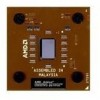AMD AXDA3200DKV4E Data Sheet - Page 23
Power Management, AMD Athlon™ XP Processor Model 10 Data Sheet
 |
View all AMD AXDA3200DKV4E manuals
Add to My Manuals
Save this manual to your list of manuals |
Page 23 highlights
26237C-May 2003 Chapter 4 Preliminary Information AMD Athlon™ XP Processor Model 10 Data Sheet must first connect the system bus. Connecting the system bus places the processor into the higher power probe state. After the Northbridge has completed all probes of the processor, the Northbridge must disconnect the AMD Athlon system bus again so that the processor can return to the low-power state. During the Stop Grant states, the processor latches INIT#, INTR, NMI, SMI#, or a local APIC interrupt message, if they are asserted. The Stop Grant state is exited upon the deassertion of STPCLK# or the assertion of RESET#. When STPCLK# is deasserted, the processor initiates a connect of the AMD Athlon system bus if it is disconnected. After the processor enters the Working state, any pending interrupts are recognized and serviced and the processor resumes execution at the instruction boundary where STPCLK# was initially recognized. If RESET# is sampled asserted during the Stop Grant state, the processor exits the Stop Grant state and the reset process begins. There are two mechanisms for asserting STPCLK#-hardware and software. The Southbridge can force STPCLK# assertion for throttling to protect the processor from exceeding its maximum case temperature. This is accomplished by asserting the THERM# input to the Southbridge. Throttling asserts STPCLK# for a percentage of a predefined throttling period: STPCLK# is repetitively asserted and deasserted until THERM# is deasserted. Software can force the processor into the Stop Grant state by accessing ACPI-defined registers typically located in the Southbridge. The operating system places the processor into the C2 Stop Grant state by reading the P_LVL2 register in the Southbridge. If an ACPI Thermal Zone is defined for the processor, the operating system can initiate throttling with STPCLK# using the ACPI defined P_CNT register in the Southbridge. The Northbridge connects the AMD Athlon system bus, and the processor enters the Probe state to service cache snoops during Stop Grant for C2 or throttling. Power Management 11















